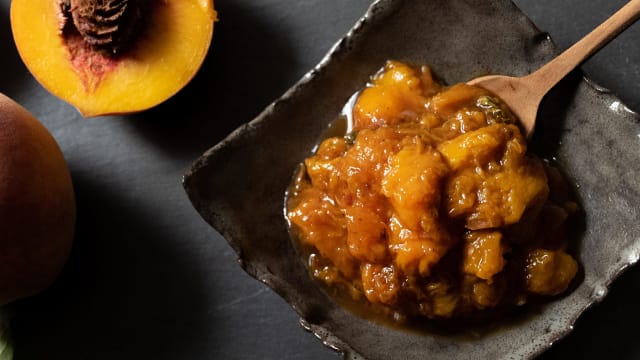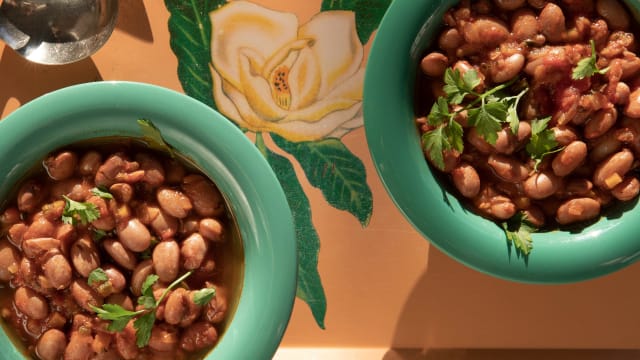Smoke & Food

One of my first big steps toward becoming a serious, capable cook involved buying a smoker. My grandfather had one, back when I was a kid — an L-shaped black steel number that he’d wheel out of the garage to light ceremoniously on the driveway. He used it to smoke chickens to an irresistibly taut umber sheen. A ceramic engineer who designed high-tech high-temperature kilns for the nascent printed circuit industry, he regaled me with detailed descriptions of the optimal temperature and humidity curves over time, at which I nodded dutifully but mostly ignored. Math and cooking never mixed easily for me, but the alluring combination of smoke and food sure did.
When I moved upstate a decade after my grandfather died, I dug more deeply into the lessons he taught me. I put in a big garden, following his, my grandmother’s, and my mother’s examples. I began fermenting pickles — at first according to his recipe, and then using a slight variation (a little less salty, plus a couple oak leaves to boost the crunch), and then quickly branching out into dozens of other ferments to handle all the incoming produce. Whatever project preoccupied me at a given time, the garden offered an unlimited source of inspiration.
Smokin' Hot Tomatoes
Many vegetables found their way into the smoker, but none clicked the way tomatoes did, especially in combination with hot peppers. Smoking peppers is ancient alchemy, but tomatoes also benefit handsomely from smoke. An hour or so bathing in it — whether from hardwood, fruit wood, or hickory — imparts addictive depth and complexity. Smoke acts like an amplifier for the five tastes, and since tomatoes have all five, it hits them extra hard, enhancing everything you love about them. An hour or so in the smoker and they’re most of the way to barbecue sauce. Those jalapeños you’ve got snuggled in there alongside them have also picked up some serious flavor, and have softened some, making them open to suggestion.
Tomato Salsa
Because tomatoes and peppers are both nightshades, there’s a seamless liaison between their flavors, lubricated by smoke and salt, that makes the salsa I turn them into an extraordinarily tasty concoction. Tomatoes are also packed with lycopene, a potent antioxidant that may support skin, eye, brain, and bone health, as well as possibly impeding the growth of some cancers.
Once smoked, it’s a simple matter of moving the tomatoes and peppers into a large stock pot and cooking them down with onion, coriander, and vinegar. A trick I learned is that if you let the tomatoes sit (separate from the peppers) in a big bowl post-smoker, they shed a fair amount of smoky tomato water. If you use a slotted spoon to lift them out, the water stays behind, naturally thickening your salsa without requiring a long boil.
One of cooking’s great gifts is unlocking methods that create byproducts as tasty as the main event. This salsa is one of those techniques; the tomato water can be the base for a dizzying number of ferments: shoyus, misos, pickles, and more.
• Use the tomato water to make brines for lacto-fermenting pickles of all sorts (it’s especially good for doubling down on the flavor of tomatoes and chiles).
• Use it to hydrate dried koji before blending it into miso or shoyu. The added layer of smoke and umami in the result can be extraordinary.
• Use it as the base for stocks, soups, gravies, and more.
Once the strained tomatoes are bubbling happily with the peppers, I add onion, coriander, and vinegar. When the onion is soft, I use an immersion blender to purée the whole pot, then I push the salsa through a food mill to remove the skins and seeds. Don’t throw these away! After you’ve dealt with the salsa, this clot of stringy goop makes an astonishingly good smoked chile powder. Just spread it into a thin layer, dehydrate it until fully dry, then blitz it into a powder in your food processor. Smoky, spicy, savory — you’ll use it on everything.
It’s worth mentioning here that I use Blue Beech tomatoes for this salsa. They’re large, heavy, bright red plum-types that often wear a little yellow on their shoulders. Unlike many paste tomatoes, their skins and seeds aren’t bitter, so they need no processing before cooking and running through the food mill.
If the salsa is still too watery for your taste, return it to the stove to reduce some more. Once it’s reduced to your liking, salt it to taste and it’s done. It can be safely canned if you’re set up to do that, or it’ll keep in the fridge for a couple of weeks if not. Besides performing admirably in all salsa-related situations, make sure you try it in some of these applications as well:
• Instant enchilada sauce: open a jar and pour. It needs nothing else.
• Instant chili base: add protein, beans, and whatever else you desire and let it simmer. I will often add some cinnamon, cumin, and oregano to round out the flavor.
• The base for all manner of tomato curries: add the spice blend of your choice and you’re off.
• Barbecue sauce: I add maple syrup, a shot of espresso, and sometimes some molasses or tamarind paste and cook it down a little until thick and sticky. It’s gorgeous.
This salsa is one of the very best things I make. It is coveted — frankly with some measure of actual anger at its scarcity in a few cases — by some of my dearest friends. If you have the gear and the inclination, I’m confident that it will become as much of a fixture in your pantry as it is in mine: a new family tradition, based on an older one, that I hope my grandchildren will tell stories about as they wow their friends with this exalted condiment.
RECIPE | Smoked Salsa
Key Takeaways
- Smokers aid nutritious cooking experiments.
- They elevate ingredients like tomatoes.
- Smokers are used to make condiments.



